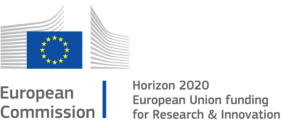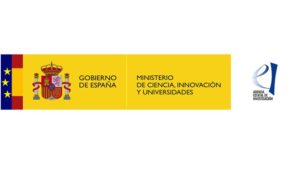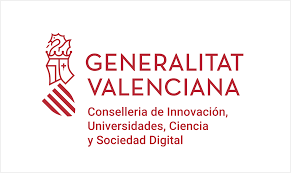Skip to content
2022
| The objective of the project is to carry out a proof-of-concept of a real-time 3D Structural Health Monitoring (SHM) system using optical fiber sensors with SDM technologies, mainly MCF fibers, embedding the sensors in composite pieces similar to those used in aerospace applications, and through an experimental setup on a certified measurement equipment, validate the proper functioning of the system. |
| PDC2021-121601-I00 Project funded by MCIN/AEI/10.13039/501100011033 and by the European Union Next GenerationEU/PRTR. |

The popularization of access to space has experienced great growth in recent years, thanks to the appearance of pico- and nanosatellites (small satellites weighing less than 10 kg). However, one of its great limitations is related to the low emission power, which is why they usually operate in low orbits (LEO) and with a high relative speed around the Earth (complicating their stable orbital position, which requires continuous corrections and adjustments). For this, omni-directional antennas are required in the VHF and UHF frequency bands that guarantee the essential communication links, associated with the telemetry, tracking and command (TT&C) subsystems. However, the limited bandwidth available at these frequencies makes them unsuitable for high-speed massive data transmissions, as required by most space applications offered from these small platforms.
To solve these needs of the new space economy (also known as new space) in the field of communications, the complete technological development (including practical demonstrator) of a high-speed data downlink operating in C band and Ku band, and with enough bandwidth to serve future applications in this new space sector, will be accomplished in this project.
A second major aim of this project is the practical demonstration of services and applications that (in connection with the identified Digital Transition needs) can be provided by small sats. In this sense, communications experiments with existing and active CubeSats and small sats, for testing their future use in scientific activities (on-board experiments), in the digital transformation of the agro-food and industrial sector (acting as IoT sensor network hub) and providing full-coverage of wideband Internet services (IoS fleets), will be performed.

In recent years, the popularization of access to space has experienced a boom thanks to the appearance of pico- and nanosatellites (small space platforms weighing less than 10 kg). This sector, with cheap design, manufacturing and launch costs, offers adequate performance for many applications, in exchange for tolerating a higher risk of failure and having a shorter useful life. It is known by the term “New Space”.
That is why, in the context of this call and in relation to Advanced Technologies for the exploration of the universe, it is considered relevant to develop a complete space mission based on this type of satellites (CubeSats). The main objective of this project is to develop, validate and finally launch into space a CubeSat, which we will call PoliTech-1, to operate with it and its different on-board payloads (in Astrophysics and Remote Sensing applications).
PoliTech-1 is the first satellite designed by the Polytechnic University of Valencia, and will be the first fully integrated satellite in the Valencian Community. The proposed mission consists of a nanosatellite that includes different payloads, developed by various university research groups: a telescopic camera for Earth observation activities (GEODEYE), which will provide remote sensing data for academic and research purposes, a communications link downlink in band C (HiDAC), which includes the transmission stage with a planar antenna, and which will be used to download the images captured by the GEODEYE payload, and a novel very compact gamma and neutron detector system (LEON) for measure cosmic radiation in orbit, characterize space weather, and assess damaging effects of ionizing cosmic radiation on satellites.

2023
2021
ACTUACIÓN COFINANCIADA POR LA UNIÓN EUROPEA A TRAVÉS DEL PROGRAMA OPERATIVO DEL FONDO EUROPEO DE DESARROLLO REGIONAL (FEDER) DE LA COMUNITAT VALENCIANA 2021-2022 (REF.:IDIFEDER/2021/088)

2022
COREMAT-6G aims at developing smart surfaces from an integral perspective, addressing from the design of the surface materials, their electromagnetic optimization, their influence on channel performance, their use for sensing and localization, as well as their management from the radio access network (RAN). The novelty of
COREMAT-6G lays on the use of novel materials capable of changing their complex dielectric
properties by adjusting their initial composition in combination with external control signals.
These materials are in addition non-metallic, of lower cost and recyclable, so improving the sustainability of the next generation networks deployment. All these concepts imply an interdisciplinary approach which accounts with highly specialized insight from different players, that will play a key role in the development,
manufacturing and commercialization of these devices as 6G technology enablers.
Therefore, this project envisions involving the participation of both the scientific community in academia and research departments at companies, to succeed in the development of smart surfaces and their application.
Concretely, COREMAT 6G (Subproject A – RIS Implementation) will be focused on the research and development of both metallic and non-metallic RIS panels using novel dielectric materials to compare their performance. To achieve this goal, the engineering and design of both the materials of the panel as well as the
design and optimization of the elements of the panel from the electromagnetic perspective will be also addressed. Besides, the physical implementation of the surface is also envisioned in the subproject, leading to a final manufactured prototype ready to be used in future applications in 6G networks (Subproject B - RIS Radio and Sensing) or to operate as an element of the network in future 6G systems (Subproject C - RIS Integration on 6G RAN).
<<Plan de Recuperación, Transformación y Resilencia- financiado por la Unión Europea -NextGenerationEU>>




The 6G vision is to connect the human, digital and physical worlds and revolves around their interaction: a human world of our senses, bodies, intelligence, and values; a digital world of information, communication and computing; and a physical world of objects and organisms. In this three-pilar vision, real-time virtual representations that serve as the real-time digital counterpart of a physical entity will be among the most innovative type of 6G applications, becoming a paradigm-changer for the supply chain management, transforming how products and services are made and delivered, while enabling the creation and sharing of supply chain information, allowing for the full digitalization of industrial elements (e.g., data, sensors, robotics, vehicles, etc). The solution takes advantage of the data gathered by sensors, machines, robots and cameras to offer a native experience that will allow design and engineering teams to interact with a virtual model in real time through a single self-contained device, and without the constraints of a physical connection. 6G real-time applications demand a tremendous amount of data collection as well as virtualization, analytics and a high computational capacity at both edge and cloud domains, which 5G may not be able to fulfil appropriately, but 5G-advanced and 6G features will. To this end, future 6G applications will need to rely on the adoption of 5G-advanced technologies which will enable the maximum exploitation of its functionalities, such as: (i) 5G-Advanced-IoT (5G-A-IoT) to connect machines and sensors on a large scale; (ii) an AI-self-managed distributed IoT-to-Edge-to-Cloud continuum platform composed of resources from different providers in a transparent manner for the end users and verticals; and (iii) the integration of AI/ML analytic tools to furnish both the applications and the IoT-to-Edge-to-Cloud continuum platform with intelligence to enable real-time performance. The complex task of collecting, managing and storing different types of data requires of a common language that allows to virtualize and analyze it as well as enable interoperability and transparency for end users. In order to accomplish this complex task, it will be necessary to make use of a wide range of distributed and centralized computation capabilities that supports the gathering, integration and processing of the data. All the required computing components will compose a computing platform that enables the low latency and physical proximity requirements of the data sources. The most-efficient approach to tackle this challenge is to integrate several commercial cloud-edge computing solutions to coexist within a logistics ecosystem, creating an IoT-edge-cloud platform self-managed with artificial intelligence. Additionally, this infrastructure will leverage and help the evolution of the currently available infrastructures in relevant industrial, logistics and ports scenarios of the supply chain, creating an impact on the future of logistics environments in Spain.
- Subproject 1: Advancing-5G-Twins 5G-IoT-edge-cloud computing platform
- Subproject 2: Advancing-5G-Twins for Industry 4.0
- Subproject 3: Advancing-5G-Twins for ports
The predictions for the coming decade depict a new era in which billions of things, humans, and connected vehicles, robots and drones will generate Zettabytes of digital information. Access to data and data ownership are increasingly the major factors in value creation, and limiting such access is a means of control. Creating a system that transforms how data is collected, shared and analyzed in real time creates strong drivers for future value and introduce novel stakeholder roles. In this context, digital twins are a perfect fit for logistics complex environments, since they permit the interconnection and full digitalization of robotics, sensors, vehicles, and processes in general. The concept of Digital Twins is presented as a mix of the best of each world. Digital twins are 3D virtual representations that serve as the real-time digital counterpart of a physical entity, becoming a paradigm-changer for the supply chain management, transforming how products and services are made and delivered, while enabling the creation and sharing of supply chain information, allowing for the full digitalization of elements such as data, sensors, robotics, vehicles, etc. The solution takes advantage of the data gathered by sensors, machines, robots and cameras to offer a native experience that will allow design and engineering teams to interact with a 3D life-size model in real time through a single self-contained device, and without the constraints of a physical connection. Digital-Twins real-time applications demand a tremendous amount of data collection as well as virtualization, analytics and rendering mechanisms. Also, DT representation requires a high computational capacity at both edge and cloud domains, which 5G may not be able to fulfil appropriately, but 5G-advanced and 6G features will. To this end, future Digital Twins applications will need to rely on the adoption of 5G-advanced technologies which will enable the maximum exploitation of Digital Twins functionalities, such as 5G-Advanced-IoT (5G-A-IoT) to connect machines and sensors on a large scale, edge and cloud computing, and the integration of AI/ML analytic tools to furnish Digital Twins with intelligence to enable real-time performance. This project will pioneer the design and development of real-time digital twins for ports in Spain by leveraging advanced 6G applications, hence increasing the Spanish competitiveness and sovereignty in future 6G logistic “killer apps”. The combination of digital twins and interactive applications from different sources will be supported across Advancing-5G-Twins for ports, helping the industry reach greater resilience levels. For this purpose, the project will create a flagship 6G application laboratory for real-time digital twins for port environments. The data gathered by sensors and cameras will be used to define requirements and Key Performance Indicators (KPIs) for 5G-Advanced and 6G in such complex scenarios. In particular, the project will devise a digital twin application for ports, taking as reference scenarios the port of Valencia, where the operational events are presented in real-time conditions. This will allow ports to be at the forefront of digitalization, positioning themselves as a worldwide point of reference for automatization. The result will be a technical blueprint for the development of standards-compliant and interoperable real-time digital twins leveraging future 6G technology and seamlessly integrated with real-time edge computing, historical AI/ML analytics as well as advanced IoT solutions.
<<Plan de Recuperación, Transformación y Resilencia- financiado por la Unión Europea -NextGenerationEU>>




Advancing-5G-Immersive aims to create a cutting-edge immersive laboratory which will serve as one of the main Spanish testbeds for stakeholders and companies willing to validate their emerging 6G applications. The project is formed by three innovative types of communications: Haptic/Tactile, Holographic, and Telepresence. For each one of them, a subproject has been assigned, since the requirements, capabilities, technology enablers and use cases are different. These credible research proposals are completely aligned to the strategic research agenda of Smart Network and Services (SNS). The reliability of the research proposal can be ensured thanks to the following facts. The management team, led by Prof. David Gomez-Barquero, has successfully coordinated three 5G-PPP projects (four H2020 projects). The projects have a strong industrial participation of large, medium and small companies with proven experience in 5G-PPP/H2020 and other excellence projects, and with previous and on-going collaborations with Prof. Gomez-Barquero. The three subprojects will foster the creation of a highly-competitive beyond 5G ecosystem in Spain, which will strength the position and participation of Spain in the upcoming SNS work program in Horizon Europe, and therefore increase the reimbursement funding of Spain in this program.
- Advancing-5G-Immersive-Holographic (Reference No. TSI-063000-2021-109) amount 1,029,422 €
- Advancing-5G-Immersive-Telepresence (Reference No. TSI-063000-2021-110) amount 902,159 €.
- Advancing-5G-Immersive-Haptic (Reference No. TSI-063000-2021-111) amount 920,420 €.
Total amount of 2.852.001 € Advancing-5G-Immersive (Immersive and holographic advanced 5G laboratory) Advancing-5G-Immersive aims to create a cutting-edge immersive laboratory which will serve as one of the main Spanish testbeds for stakeholders and companies willing to validate their emerging 6G applications. The project is formed by three innovative types of communications: Haptic/Tactile, Holographic, and Telepresence. For each one of them, a subproject has been assigned, since the requirements, capabilities, technology enablers and use cases are different. These credible research proposals are completely aligned to the strategic research agenda of Smart Network and Services (SNS). The three subprojects will foster the creation of a highly-competitive beyond 5G ecosystem in Spain, which will strength the position and participation of Spain in the upcoming SNS work program in Horizon Europe, and therefore increase the reimbursement funding of Spain in this program. This project will be carried out through the three subprojects: Advancing-5G-Immersive-Holographic (ADV5G-IMM-HOLOGR), Advancing-5G-Immersive-Telepresence (ADV5G-IMM-TELEP), Advancing-5G-Immersive-Haptic (ADV5G-IMM-HAPTICS). The overall objective of Advancing-5G-Immersive project is twofold. On one side, the project aims to create a flagship 6G application laboratory for three emerging type of communications that impose new requirements on the telecommunication network infrastructure that cannot be met with existing 5G networks: Emerging human-centric immersive applications (i.e. holographic, telepresence and haptics communications), that are expected to revolutionize the work and everyday life of citizens. The three subprojects will pioneer the design and development of advanced 6G applications in Spain, increasing the Spanish competitiveness and sovereignty in future 6G “killer apps”. The laboratory will be also fundamental to define the Key Performance Indicators (KPI) and requirements for 5G-Advanced and 6G. On the other side, the three Advancing-5G-Immersive subprojects will research new promising technologies to optimize the delivery and implementation of the considered 6G applications, including: The combination of enhanced Mobile Broadband (eMBB) with the low-latency features of Ultra-Reliable Low Latency Communications (URLLC), 5G-Advanced broadcast with Non-Terrestrial Networks (NTN), and softwarized core and radio components for holographic, telepresence and haptic communications. Call for applications for grants PROGRAMME FOR UNIVERSALIZATION OF DIGITAL INFRASTRUCTURES FOR UNICO-5G COHESION R&D 2021 published in BOE, on November 24, 2021 belonging to the Plan/Programme Plan for Recovery, Transformation and Resilience of the Government of Spain. From 29/11/2021 to 31/12/2024. The overall objective of the project is to create a flagship 6G application laboratory for real-time digital twins for industrial environments, which impose new requirements on the telecommunication network infrastructure in these vertical industries, and to progress beyond the current state of the art on new promising technological trends to enable the implementation of real-time digital twins, such as 5G-Advanced Internet-of-Things (IoT), edge and cloud computing, and real-time AI/ML (Artificial Intelligence/Machine Learning) analytics. This project is divided in three subprojects: Advancing-5G-Digital Twins. 5G-IoT platform with edge and cloud computing (ADV5G-TWINS-CLOUD), Advancing-5G-Digital Twins for Industry 4.0 (ADV5G-TWINS-INDUSTRY), Advancing-5G-Digital Twins for Industry 4.0 (ADV5G-TWINS-INDUSTRY). Call for applications for grants PROGRAMME FOR UNIVERSALIZATION OF DIGITAL INFRASTRUCTURES FOR UNICO-5G COHESION R&D 2021 published in BOE, on November 24, 2021 belonging to the Plan/Programme Plan for Recovery, Transformation and Resilience of the Government of Spain. From 29/11/2021 to 31/12/2024.
<<Plan de Recuperación, Transformación y Resilencia- financiado por la Unión Europea -NextGenerationEU>>




2019
Space sector is key and strategical asset for Europe to face global challenges, which must continue to be developed to have a prominent role in the world, contributing to the independence security and prosperity of Europe. Since satellite payload RF components and systems are essential for delivering mission objectives and supporting ground equipment, new technologies and techniques are required to respond to emerging satellite applications and technology challenges. To this end, TESLA ETN (European Training Network) will create a multidisciplinary research environment to develop the Advanced Technologies for future European Satellite Applications. It will set up collaborations with senior staff in academic and industrial sectors to conduct top research into new and enabling technologies for satellite flexible payloads, big constellation systems, satellite high-speed communications and remote sensing, as well as large satellite platforms. TESLA will also implement a unique research program, with the objective to push the next generation of creative, entrepreneurial and innovative satellite communication developers, to enhance the European space economy and business through outreach activities for a wider economic and social impact.
Participating entities: Universidad Politécnica de Valencia (UPV), Heriot-Watt University (HWU), Universidad Pública de Navarra (UPNA), Christian-Albrechts-Universitaet zu Kiel (CAU), Kungliga Tekniska Hoegskolan (KTH), Technische Universitaet Graz (TU GRAZ), Universita degli Studi di Perugia (UNIPG).


2018
SELECTOR project (funded as an H2020 Research and Innovation Action) is focused on the development of innovative passive components to increase the number of freely accessible space qualified passive components; thus, contributing to the European policy about “Reaching non-dependence in certain technologies that will open new markets to industries and will increase the overall competitiveness of the European Space sector”.
SELECTOR aims at developing Surface Mount Technology (SMT) compatible electromechanical switches for space sector high miniaturization. These devises called “Miniature Electro-Mechanical Relay” (MEMR), already exist for microwave industrial ground application like Automatic Test Equipment. SELECTOR will deliver MEMR as part of ESA portfolio European Preferred Part List (EPPL) so that this high integration, high performance passive component be available with non-restriction for the whole European industry. SELECTOR will also demonstrate a whole new approach of self-redundant microwave equipment called “Meta-equipment” based on microwave specific SMT board level assembly and MEMR components to minimize cost and improve integration. This demonstrator will address Very High Throughput Satellites (VHTS) emerging applications, where the new paradigm is the introduction of digital technologies dealing with very high number of RF chains. New evolution toward RF high power and high frequency capability will be implemented to open-up new sector of application within Space satellites (Navigation, earth observation), but also non-space sectors.
In the framework of this project, the GAM group is directly involved in the (theoretical and practical) evaluation of the new developed passive components in terms of high-power and high-frequency space applications.
Participating entities: Universidad Politécnica de Valencia (UPV), Radiall, Thales Alenia Space France (TASF), Centre Suisse d’Electronique et de Microtechnique SA (CSEM).


2020
The most relevant European satellite communication systems and applications are currently supporting a huge number of services of modern Digital Society. Among them, we highlight the global navigation system GALILEO, meteorological and Earth Observation programs like COPERNICUS, nanosatellites for scientific missions and big constellations of small satellites for implementing the upcoming “Internet of Satellites”, as well as large Telecommunication satellites in geostationary orbit. Thanks to these satellite payloads, many civil and military applications and a wide variety of sectors are being benefitted globally. With the aim of keeping the growing rate of such applications, all cited space programs are already deploying their future evolutions. Among them, one can find the Galileo second generation project, the next generations of meteorological (METEOSAT and METOP) satellites, the near future SENTINEL missions, the coming breed of small platforms for Starlink and OneWeb constellations, and the new large multi-beam space platforms operating in the millimetre wave (and sub-millimetre wave) frequency ranges (up to some terahertz). All these next-generation satellites will need more advanced communication payloads based on novel equipment with more stringent requirements. The main aim of this coordinated project is to address all identified challenges by designing novel passive components and antennas for next-generation satellite communication systems, including their prototyping and experimental validation. For that purpose, the four sub-projects will closely work on all available high-frequency technologies: i.e. more classical ones based on planar circuits and waveguides, more recent integrated planar waveguides with/without dielectric substrate, and the promising concept of gap waveguides. Advanced materials (such as bioplastics, artificial materials, liquid crystals, and also gallium nitride and graphene for terahertz frequencies), as well as manufacturing techniques (classical milling, 3-D fabrication methods, LTCC and micromachining processes), will be also investigated.
Participating entities: U.R.I. of Telecommunications and Multimedia Applications (ITEAM) of the Polytechnic University of Valencia (UPV), Department of Information and Communication Technologies of the Polytechnic University of Cartagena (UPCT), Department of Physics, Systems Engineering and Theory of Sign of the University of Alicante (UA) and the U.R.I. of Technologies, Construction and Telecommunications (ITCT) of the University of Castilla la Mancha (UCM). 
2019
Space communication systems, which currently operate in the lower microwave bands, provide key scientific, technological and social services, as well as critical security and defence applications. Since 2006, space communications offer broadband (10 Gbps), TV and video on demand, deep space communications and military applications. Today, the 2nd generation of Ka-band satellites, currently under development and with transmission rates greater than 100 Gbps, will be able to offer advanced mobile communications services, navigation and Earth observation systems, with huge civil, security and defence purposes.
To meet all these emerging applications, future satellites will incorporate new and advanced communications payloads, whose equipment and subsystems (passive components such as filters, with various responses and functions, diplexers and multiplexers, as well as antennas) will require technological specific solutions, better adapted to each specific scenario. Thus, this R&D project aims to offer solutions (through the design, implementation and experimental validation of specific technological demonstrators) to these great challenges in new high-frequency equipment (passive components and antennas) for future space applications. In order to achieve this, the most appropriate technologies (more classic ones such as planar and waveguides, or more recent ones such as the hybrid guided-planar SIW and its novel embodiments without dielectric substrate -ESIW and ESICL-, or guides with corrugated walls also known as groove gap waveguide), the materials (dielectrics, ferrites and liquid crystal) and novel manufacturing techniques (LTCC and additive manufacturing) will be considered in each application.













